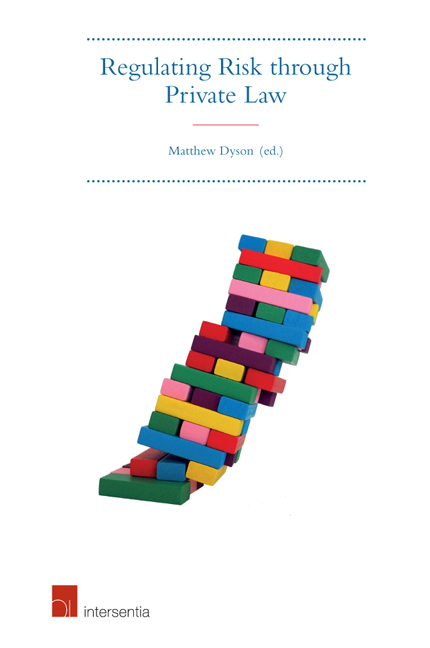Book contents
- Frontmatter
- Preface
- Contents
- Table of Cases
- List of Contributors
- Chapter 1 Introduction
- Part I Risk Overviews
- Chapter 2 Risk and english tort law
- Chapter 3 Risk and French Private Law
- Chapter 4 Risk in Swedish Tort Law: Of Models and Muddles
- Chapter 5 Risk and Italian Private Law
- Chapter 6 Regulating Risk Through Private Law: The Spanish Approach
- Chapter 7 How Dutch Tort Law Responds to Risks
- Chapter 8 Risk and Chilean Private Law
- Chapter 9 Regulating Risk Through Private Law: South Africa
- Chapter 10 Risk and Brazilian Private Law
- Part II State of the national art on risk
- Index
- About the Editor
Chapter 7 - How Dutch Tort Law Responds to Risks
from Part I - Risk Overviews
Published online by Cambridge University Press: 13 October 2018
- Frontmatter
- Preface
- Contents
- Table of Cases
- List of Contributors
- Chapter 1 Introduction
- Part I Risk Overviews
- Chapter 2 Risk and english tort law
- Chapter 3 Risk and French Private Law
- Chapter 4 Risk in Swedish Tort Law: Of Models and Muddles
- Chapter 5 Risk and Italian Private Law
- Chapter 6 Regulating Risk Through Private Law: The Spanish Approach
- Chapter 7 How Dutch Tort Law Responds to Risks
- Chapter 8 Risk and Chilean Private Law
- Chapter 9 Regulating Risk Through Private Law: South Africa
- Chapter 10 Risk and Brazilian Private Law
- Part II State of the national art on risk
- Index
- About the Editor
Summary
INTRODUCTION
An important part of analysing Dutch tort law has been devoted to the way the law should and does deal with situations characterised by (technological or health) risk. Important focal points in the case law include the line of cases decided by the Dutch Supreme Court (Hoge Raad) concerning asbestos (prescription, duty of care, causation), the DES case (on alternative causation), and the District Court case dealing with the possible liability of the tobacco industry for the harms of smoking; however, the (lower) courts trying to handle litigation concerning workmen’ s diseases probably due to, for example, lead paint poisoning could also be alluded to. Perhaps the most famous recent example is the Urgenda case on climate change litigation.
The concept of risk has therefore been an important trigger for judicial developments and thus in legal practice in the field of liability law (as tort is called in the Netherlands). Given that state of play, this chapter aims to advance our understanding of how liability in Dutch law does, and how it should, relate to risks. In doing so, we especially focus on how the tort law system can and/or should deal with new, until recently unknown risks (think of nanotechnology, new toxic substances and the like), looking at these risks from the current state of the law. Thus we seek to show how risk should be understood and constructed, how the Dutch legal system responds to risk and what legal techniques it uses to reduce risk.
CONCEPTUALISATION OF RISK AND UNCERTAINTY
LACK OF CONCEPTUALISATION IN RULINGS
In their rulings, courts do not explicitly refer to definitions of risk and uncertainty, nor do they seem to be relying on established concepts of risk. For their part, Dutch scholars have only recently started to delineate the concepts of risk and uncertainty, relating them to liability law and highlighting the implicit links between risk and uncertainty on the one hand and case law and the distribution of responsibility for risks on the other hand.
THE CONCEPT OF RISK
In Ancient Greek, the term rhíza (which means ‘cliff’) denoted the ‘hazards of sailing too near to the cliff s: contrary winds, turbulent downdraughts and swirling tides.’ In Dutch, the term risico first appeared in 1525 and denoted the possibility of harm to trade and merchandise.
- Type
- Chapter
- Information
- Regulating Risk through Private Law , pp. 165 - 194Publisher: IntersentiaPrint publication year: 2018



